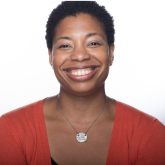Can you hear an eclipse?
When accessibility experts like Regine Gilbert get involved, anything’s possible
As a user experience designer and author of the book Inclusive Design for a Digital World, Industry Assistant Professor Regine Gilbert seeks to make the world a more accessible place. It seems exceptionally fitting that she and her Integrated Digital Media students are partnering with the Advanced Research In STEAM Accessibility (ARISA) Lab, an organization dedicated to making science enriching and open to all.

The Tandon team will be participating in ARISA’s Eclipse Soundscapes Project, an initiative that had been inspired by anecdotal accounts that suggest animal behavior may change during a total solar eclipse. According to one story, at the moment of totality, when the moon blocked out the sun, a chorus of crickets began chirping. As soon as the light returned, the crickets stopped. The project’s creators realized that if eclipses affect the earth in ways that can be experienced and measured using a variety of senses, not merely sight, even the visually impaired could get excited about eclipse research.
Now, through a series of workshops led by subject matter experts from NASA’s Science Mission Directorate, citizen scientists will collect audio recordings from eclipses and analyze acoustic data to determine how disruptions in light and circadian rhythms may affect ecosystems. The data will include soundscapes recorded during the 2017 total solar eclipse, as well as recordings from the upcoming 2023 annular eclipse and 2024 total solar eclipse.
All workshops, materials, and learning interfaces will be designed to the highest degree of accessibility, with an emphasis on physical, social, and cognitive inclusion, and that’s where Gilbert and her students come in: they’ll be designing, implementing, and testing all citizen-scientist web interfaces for the project, which was recently approved for a five-year cooperative agreement from the NASA Science Mission Directorate’s Science Activation Program.
“The goal of the current project is not just to get the public involved in studying this one single topic, no matter how fascinating,” said Gilbert. “We aim to develop a framework for improving accessibility and inclusion in the study of science, technology, engineering, the arts, and math — along with the intersections between them — in a much broader sense. ”




